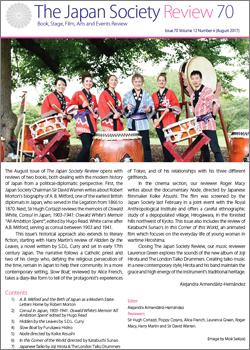Issue 70 (August 2017, Volume 12, Number 4)

The August issue of The Japan Society Review opens with reviews of two books, both dealing with the modern history of Japan from a political-diplomatic perspective.
First, the Japan Society Chairman Sir David Warren writes about Robert Morton’s biography of A. B. Mitford, one of the earliest British diplomats in Japan, who served in the Legation from 1866 to 1870.
Next, Sir Hugh Cortazzi reviews the memoirs of Oswald White, Consul in Japan, 1903-1941: Oswald White’s Memoir “All Ambition Spent”, edited by Hugo Read. White came after A.B. Mitford, serving as consul between 1903 and 1941.
This issue’s historical approach also extends to literary fiction, starting with Harry Martin’s review of Hidden by the Leaves, a novel written by S.D.L. Curry and set in early 17th century Japan. The narrative follows a Catholic priest and two of his clergy who, defying the religious persecution of the time, remain in Japan to help their community.
In a more contemporary setting, Slow Boat, reviewed by Alice French, takes a diary-like form to tell of the protagonist’s experiences of Tokyo, and of his relationships with his three different girlfriends.
In the cinema section, our reviewer Roger Macy writes about the documentary Node, directed by Japanese filmmaker Koike Atsushi. The film was screened by the Japan Society last February in a joint event with the Royal Anthropological Institute and offers a careful ethnographic study of a depopulated village, Hirogawara, in the forested hills northwest of Kyoto.
This issue also includes the review of Katabuchi Sunao’s In this Corner of this World, an animated film which focuses on the everyday life of young woman in wartime Hiroshima.
Closing The Japan Society Review, our music reviewer Laurence Green explores the sounds of the new album of Joji Hirota and The London Taiko Drummers. Creating taiko music in a new contemporary style, Hirota and his band maintain the grace and high energy of the instrument’s traditional heritage.
Contents
- A. B. Mitford and the Birth of Japan as a Modern State: Letters Home by Robert Morton
- Consul in Japan, 1903-1941. Oswald White’s Memoir ‘All Ambition Spent’ edited by Hugo Read
- Hidden by the Leaves by S.D.L. Curry
- Slow Boat by Furukawa Hideo
- Node directed by Koike Atsushi
- In this Corner of the World directed by Katabuchi Sunao
- Japanese Taiko by Joji Hirota & The London Taiko Drummers
Contributors
Editor
Alejandra Armendáriz-Hernández
Reviewers
Sir Hugh Cortazzi, Poppy Cosyns, Alice French, Laurence Green, Roger Macy, Harry Martin and Sir David Warren.

